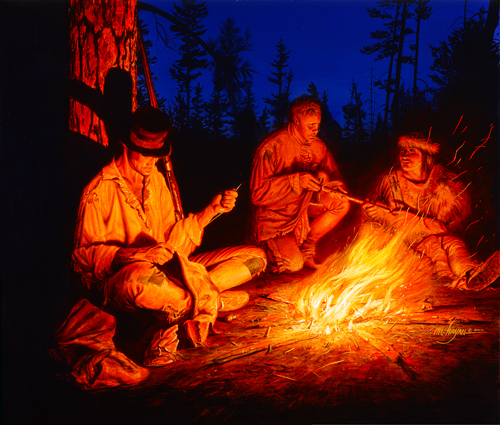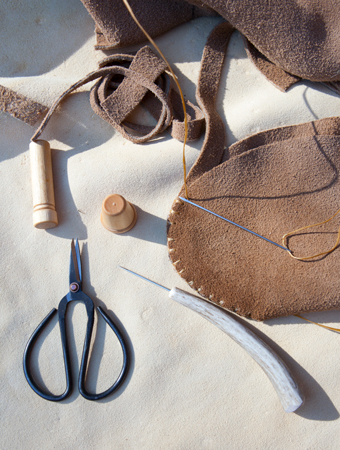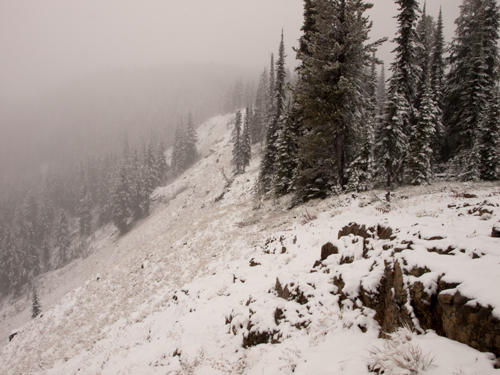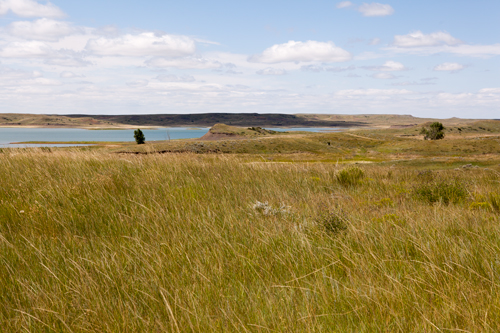Joseph Whitehouse Sews by Firelight
© Michael Haynes, https://www.mhaynesart.com. Used with permission.
On Christmas Eve, 24 December 1803, the members of the Corps of Discovery finished covering their newly constructed huts in their camp on the River Dubois (Wood River), in present Illinois, across the Mississippi from St. Louis. Christmas day brought snow, with ice running in the river, and the men celebrated by firing their rifles, carousing, and hunting; some got drunk and two fought. After such a boisterous day, they must have been a bit tired on 26 December 1803; the weather had moderated a bit, and two members of the party began sawing lumber with a whipsaw: Clark’s slave York and Joseph Whitehouse.[1]Gary Moulton, The Journals of the Lewis & Clark Expedition, 13 vols. (Lincoln: University of Nebraska Press, 1983-2004), 12:140-141. Thus, Joseph Whitehouse enters the written record of the Lewis and Clark Expedition.
Whitehouse was born in Fairfax County, Virginia about 1775 and moved with his family to Kentucky when he was about 10 years old. He enlisted in the regular army in 1798 and was serving in the First Infantry Regiment, at Kaskaskia, when he transferred to the “Corps of Volunteers for North Western Discovery” in late 1803. Whitehouse’s military record shows that he was 5’10” tall, and had light brown hair, a fair complexion, and hazel eyes.[2]Donald Jackson, Letters of the Lewis and Clark Expedition with Related Documents, 1783–1854, 2nd ed., 2 vols. (Urbana: University of Illinois Press, 1978), 1:343; Moulton, 2:524; Moulton, … Continue reading
A Tailor’s Tools
Photo © 2013 by Kristopher K. Townsend. Permission to use granted under the Creative Commons Attribution-Share Alike 4.0 International license.
Two Dugout Canoes
Photo © 2011 by Kristopher K. Townsend. Permission to use granted under the Creative Commons Attribution-Share Alike 4.0 International license.
When imagining the danger Whitehouse faced on the Big Hole River, consider that the two replica canoes in this figure are small, unloaded, and resting on flat water.
—Kristopher Townsend, Ed.
Lolo Trail near Snowbank Camp
Photo © 2010 by Kristopher K. Townsend. Permission to use granted under the Creative Commons Attribution-Share Alike 4.0 International license.
Whitehouse’s Creek
Missouri River near Duck Creek
Photo © 25 July 2013 by Kristopher K. Townsend. Permission to use granted under the Creative Commons Attribution-Share Alike 4.0 International license.
Captain Lewis honored Whitehouse on 23 July 1805 in present Broadwater County in Montana:
passed a large creek on Lard. side 20 yds. wide which after meandering through a beautifull and extensive bottom for several miles nearly parallel with the river discharges itself opposite to a large cluster of islands which from their number I called the 10 islands and the creek Whitehous’s Creek, after Josph. Whitehouse one of the party.[3]Moulton, 4:419-420, 422n2.
The creek has since become known as Duck or Gurnett Creek.
Tailor
Whitehouse served in the First Squad under the command of a Sgt. Nathaniel Pryor. During the winter and early spring at Camp River Dubois, Whitehouse either became disenchanted with the plans for the Expedition or was disciplined for some sort of misconduct. At any rate, he later wished to continue and was selected for the permanent party.[4]Moulton, 2:187-188, 11:xiv-xv.
Prior to the Expedition, Whitehouse had been a “skin dresser.” During the Expedition, he served as the chief tailor, an indispensable job for a journey that lasted the better part of three years during which the men’s original clothing wore out. Whitehouse’s journal entries reveal that he was employed in making the most complex items of clothing from animal skins, while others with perhaps less skill made simpler garments.[5]Moulton, 11: 187, 220-221, 245, 280-281; Robert J. Moore, Jr. and Michael Hayes, Lewis and Clark, Tailor Made, Trail Worn: Army Life, Clothing & Weapons of the Corps of Discovery (Helena: … Continue reading
Journalist
Joseph Whitehouse produced one of only six known journals written by the members during expedition. His is the only one known to exist that was written by a private. (Evidence indicates that Private Robert Frazer also wrote a journal, but it has never been found.) Whitehouse’s original journal covers from 14 May 1804 until 6 November 1805, and contains approximately 55,300 words. As he was dying, Whitehouse gave his original journal to his Catholic confessor, perhaps around 1860, and it changed hands several times before being purchased by Dodd, Mead and Company for the use of Reuben Gold Thwaites as he was compiling his 1904 edition of the journals. In 1966, a manuscript comprising a “second volume” that covered 14 May 1804 until 2 April 1806 was discovered. It was written by a different author and includes paraphrased versions of Whitehouse’s own entries for corresponding dates. Both documents reside in the Newberry Library of Chicago.[6]Moulton, 11:xv-xvi; Robert Betts, “‘The writingest explorers of their time:’ New Estimates of the Number of Words in the Published Journals of the Lewis and Clark Expedition, … Continue reading
The private’s first journal entry shows his enthusiasm as the expedition set off from Camp River Dubois:
hard Showers of rain. . . . Capt. Lewis is now at St. Louis but will join us at St. Charls. about 3 Oclock P.M. Capt. Clark and the party consisting of three Sergeants and 38 men who manned the Batteaux and perogues. we fired our Swivel on the bow hoisted Sail and Set out in high Spirits for the western Expedition. we entered the mouth of the Missourie haveing a fair wind Sailed abt. 6 miles and Camped on the North Side.—[7]Moulton, 11:1.
Whitehouse suffered from the physical demands of traveling across the continent, and made telling descriptions of some of them. Unexpected changes in the weather proved hazardous such as occurred on the Missouri River in Roosevelt County, Montana:
about 12 oClock the wind rose So high that we were oblidged to halt . . . . I and one more was in the cannoe and ware obledged to lay out all night without any blanket. it being verry cold I Suffered verry much.[8]Moulton, 11:142.
Stern Accident
On the Big Hole River, near present Twin Bridges, Montana, Captain Lewis described this near fatal accident:
Whitehouse had been thrown out of one of the canoes as she swing in a rapid current and the canoe had rubed him and pressed him to the bottom as she passed over him and had the water been 2 inches shallower must inevitably have crushed him to death . . . . Whitehouse is in much pain this evening with the injury . . . .[9]Moulton, 5:53-54.
In contrast, Whitehouse’s version for the same date seemed more concerned about the effect on the expedition:
in going through a difficult place . . . one canoe got up Set and everry perticle of the loading got wet . . . . I was in the Stern when She Swang & jumped out to prevent hir from turning over but the current took hir round So rapid that caught my leg under hir and lamed me & was near breaking my leg. lost my Shot pouch powder horn full of powder a bunch of thred and Some mockisons &c. the remainder of the loading Saved.[10]Moulton, 11:257-258.
Bitter Weather
In the Bitterroot Mountains, Whitehouse again demonstrates his concern for the others when he described how some did not have proper clothing for the cold, snowy conditions:
when we awoke this morning to our great Surprise we were covred with Snow which had fallen about 2 Inches the latter part of last night, and continues a verry cold Snow Storm . . . . we mended up our mockasons. Some of the men without Socks raped rags on their feet, and loaded up our horses and Set out without any thing to eat, and proceeded on. could hardly See the old trail for the Snow.[11]Moulton, 11:318.
Civilian Struggles
After the expedition, Whitehouse appears to have struggled with civilian life. Only days after reaching St. Louis, he sold his land warrant granted to him for his service to fellow member George Drouillard. Soon thereafter, Whitehouse signed a contract with fur trader Manuel Lisa, and then defaulted. Two years later, he was sued, the first of a series of bad debt cases. In December 1807, Whitehouse re-enlisted in the army and served at Fort Osage on the Missouri frontier. In 1813, he was demoted from corporal to private, and during 1814 fought around Niagara Falls in the War of 1812. He joined the artillery in 1816, but deserted the following year and disappeared. Reuben Gold Thwaites believed that Whitehouse died around 1860.[12]Jackson, 1:344; Moulton, 11:xv. Morris, 156-157, 200; Cutright, 114.
Team Player
Since the expedition, the Joseph Whitehouse legacy has grown in popularity in no small part due to his engaging descriptions of the journey as experienced by the common soldier. Often, he appears to be more concerned about his fellow soldiers, than his own well-being. This favorable characteristic is presently described as “being a team player.”
Notes
| ↑1 | Gary Moulton, The Journals of the Lewis & Clark Expedition, 13 vols. (Lincoln: University of Nebraska Press, 1983-2004), 12:140-141. |
|---|---|
| ↑2 | Donald Jackson, Letters of the Lewis and Clark Expedition with Related Documents, 1783–1854, 2nd ed., 2 vols. (Urbana: University of Illinois Press, 1978), 1:343; Moulton, 2:524; Moulton, 11:xiv-xv; Larry Morris, The Fate of the Corps: What Became of the Lewis and Clark Explorers after the Expedition (New Haven: Yale University Press, 2004), 200; Mike Crosby, Joined by a Journey: The Lives of the Lewis and Clark Corps of Discovery (Salmon, Idaho: U.S. Dept. of the Interior, Bureau of Land Management, Salmon Field Office, 2005), 43. |
| ↑3 | Moulton, 4:419-420, 422n2. |
| ↑4 | Moulton, 2:187-188, 11:xiv-xv. |
| ↑5 | Moulton, 11: 187, 220-221, 245, 280-281; Robert J. Moore, Jr. and Michael Hayes, Lewis and Clark, Tailor Made, Trail Worn: Army Life, Clothing & Weapons of the Corps of Discovery (Helena: Farcountry Press, 2003), 93, 230, 234, 242; Morris, 200. |
| ↑6 | Moulton, 11:xv-xvi; Robert Betts, “‘The writingest explorers of their time:’ New Estimates of the Number of Words in the Published Journals of the Lewis and Clark Expedition, “ We Proceeded On, Vol. 7, No. 3 (August 1981); Paul Russell Cutright, A History of the Lewis and Clark Journals, (Norman: University of Oklahoma Press, 1976), 113-114. |
| ↑7 | Moulton, 11:1. |
| ↑8 | Moulton, 11:142. |
| ↑9 | Moulton, 5:53-54. |
| ↑10 | Moulton, 11:257-258. |
| ↑11 | Moulton, 11:318. |
| ↑12 | Jackson, 1:344; Moulton, 11:xv. Morris, 156-157, 200; Cutright, 114. |
Experience the Lewis and Clark Trail
The Lewis and Clark Trail Experience—our sister site at lewisandclark.travel—connects the world to people and places on the Lewis and Clark Trail.
Discover More
- The Lewis and Clark Expedition: Day by Day by Gary E. Moulton (University of Nebraska Press, 2018). The story in prose, 14 May 1804–23 September 1806.
- The Lewis and Clark Journals: An American Epic of Discovery (abridged) by Gary E. Moulton (University of Nebraska Press, 2003). Selected journal excerpts, 14 May 1804–23 September 1806.
- The Lewis and Clark Journals. by Gary E. Moulton (University of Nebraska Press, 1983–2001). The complete story in 13 volumes.






